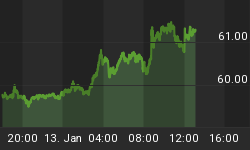As a general rule, the most successful man in life is
the man who has the best information
With gold stocks, bigger is almost always better. When you look at the cash costs of the industry, almost all the lowest cost producers are major mining companies. Larger production means more ounces to amortize costs, so a lower cost per ounce.
There are two ways to become a major - buy it or discover/develop it. "It" is the production base of one million ounces. Barrick Gold Corp. discovered the large Goldstrike Mine in Nevada in the early 1980s, developed it and rode that success to be one of the largest gold companies in the world.
Three of the most successful gold mining companies that are on the cusp of "major" status are Alamos, Eldorado and Agnico-Eagle. Each has been able to not only increase their production over the last few years, but also improve their profitability per ounce of gold produced. (In an era where cost increases have almost tracked the price of gold, this is no small feat.)
However, these stocks have also had huge runs as the market has priced in a lot of their growth. Investors looking for leverage want to look at growing gold producers on the next rung down to find ones just about to begin this run - which for these 3 meant 500% over 3-4 years with, aside from last October's crash - very little volatility.
Don't get me wrong - don't sell those stocks if you own them. Their high growth rates and low costs say their share prices should continue to grow with gold staying steady. But a couple junior gold producers look ready to make the leap to intermediates in both ounces produced and pro forma cash flow: New Gold and Red Back Mining. Both are increasing production and decreasing costs.
In scouring research reports from several Canadian brokerage firms and picking apart the forecast organic growth in gold production along with cost per ounce, these two companies appear to have the best potential for large increases in cash flow.
In their presentation (available at www.newgold.com), New Gold NGD.tsx shows their forecast organic production growth moving up from 346,000 ounces of gold this year to 438,000 ounces in 2013. This is not a huge jump, but when you combine it with their cost per ounce decreasing from $482 - $309 per ounce over the same time, their theoretical gross cash flow growth and given a constant gold price of say...$900 per ounce, cash flow jumps from $144.6 million to $258.8 million - a 79% increase.
Red Back RBI.tsx is a producer in West Africa with a strong balance sheet and a growing production profile - however their costs are not going much lower over the next 4-5 years. Their production is forecast to grow from 360,000 ounces this year to 515,000 ounces in 2013, while costs per ounce are expected to decrease marginally from roughly $400 to about $380.
Still, that means potential organic gross cash flow growth, again at a constant of $900/oz gold, of $87 million, or 49%, from $180 million to $267.8 million for Red Back.
While their cash flow growth isn't as high as New Gold's they have no debt, and fewer shares outstanding. For both companies, these numbers represent low-risk organic growth with assets they already have.
There are truly very few junior gold mining companies that are on track like these two - it was not a large list to choose from. With increased production and decreased costs, they will soon be considered intermediate producers - which could mean a substantial re-rating upward in the market. .
Many gold companies say they can grow their cash flow and build a major mining company. Few can do it. While there are no guarantees in life, both New Gold and Red Back Mining at least have an executable game plan to take the next step to major status.
If you're interested in the junior resource market and would like to learn more please come and visit us at http://www.aheadoftheherd.com/
















